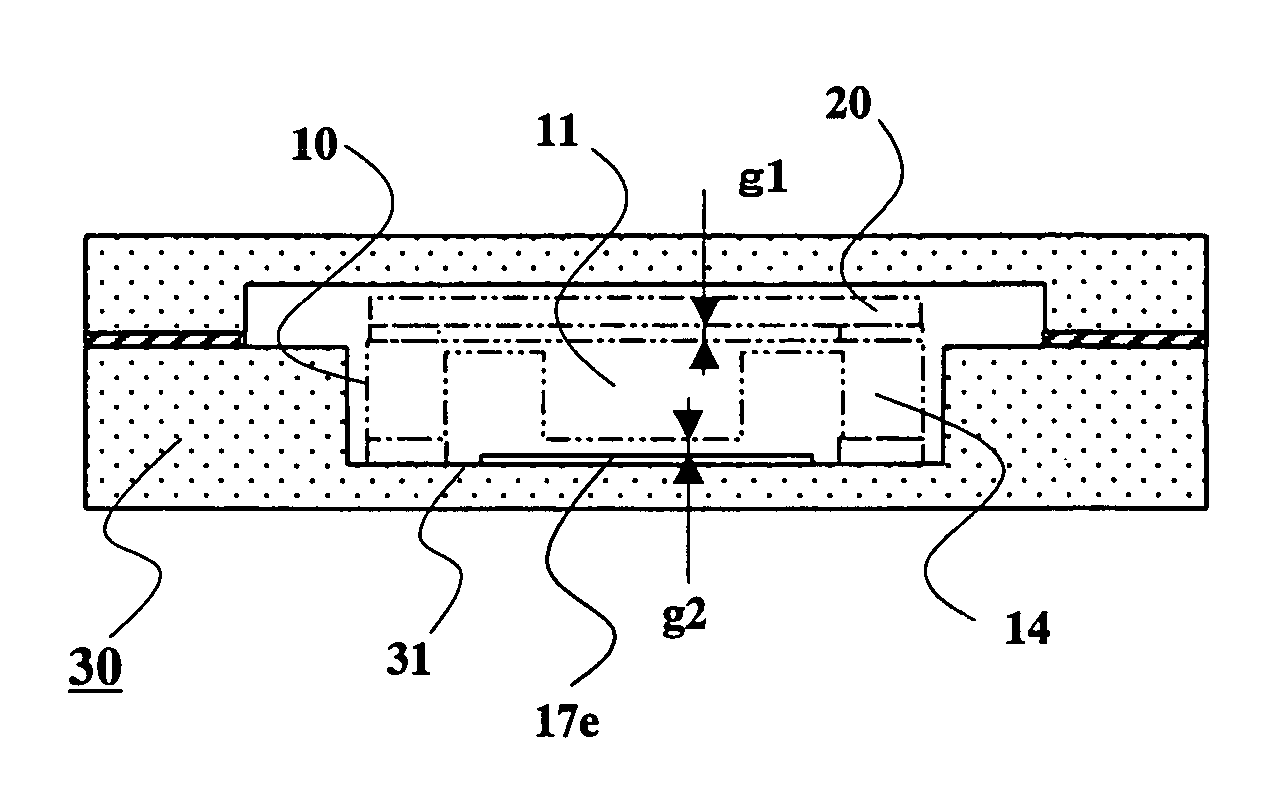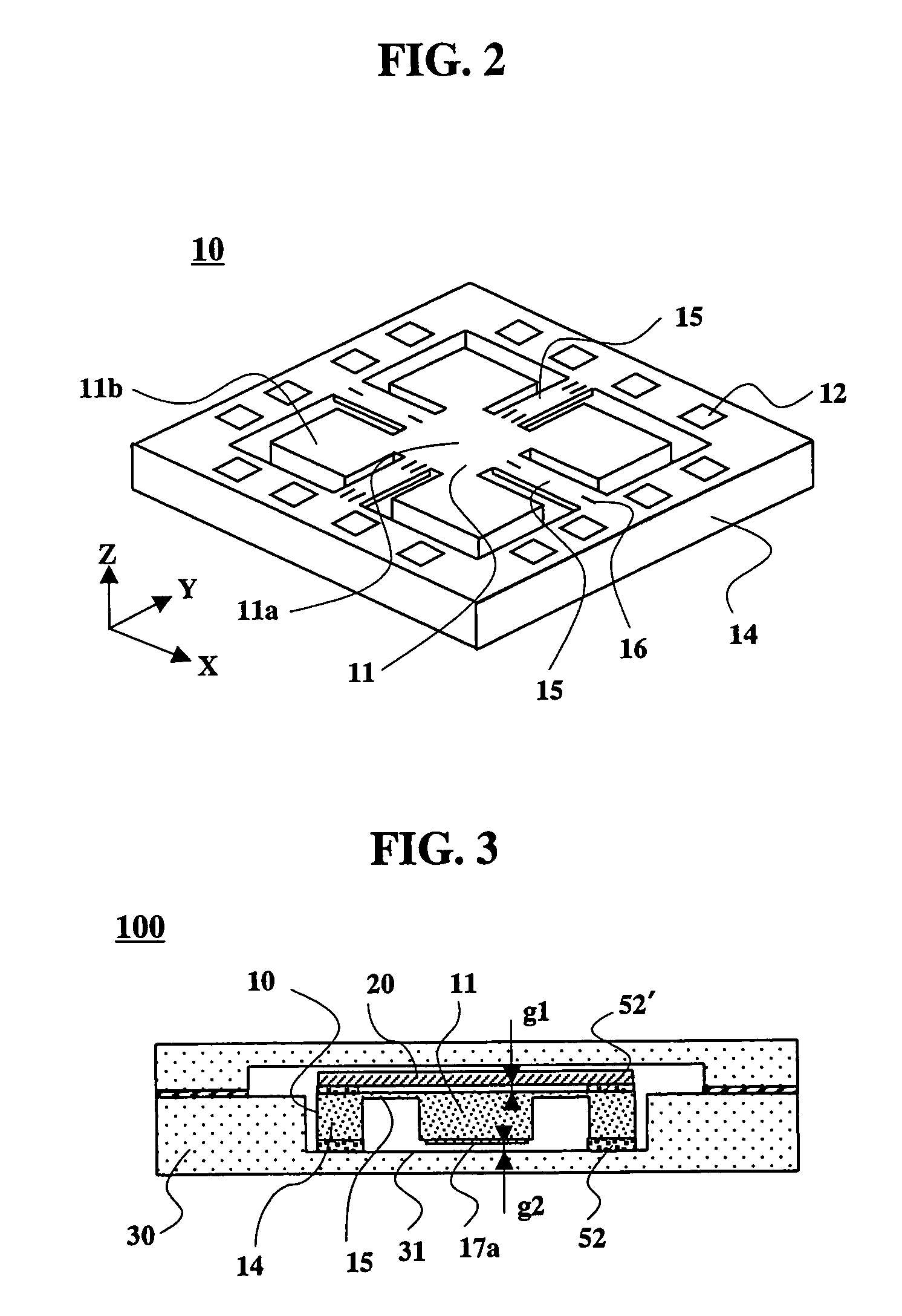Impact-resistant acceleration sensor
a sensor and acceleration technology, applied in the field of acceleration sensors, can solve the problems of ridges or corners of the bottom surface of the weight made of silicon chipping at a certain low frequency, excessive weight amplitude, and breakage of elastic arms, and achieve the effect of high impact resistan
- Summary
- Abstract
- Description
- Claims
- Application Information
AI Technical Summary
Benefits of technology
Problems solved by technology
Method used
Image
Examples
example 1
[0042]An embodiment of an acceleration sensor of the present invention will be explained, referring to FIGS. 1 to 4. FIG. 1 shows an exploded perspective view of the acceleration sensor of the present invention, FIG. 2 shows a perspective view showing an acceleration sensor element used in the acceleration sensor of the present invention, and FIG. 3 shows a sectional view taken along the line III-III in FIG. 1. FIG. 4 is a perspective view of the acceleration sensor element shown in FIG. 2, observed from the bottom. In the acceleration sensor 100 of the present invention, a regulation plate 20 made of a soda lime glass of 0.3 mm thick is bonded onto a top surface of the acceleration sensor element 10 by using adhesive 52′ mixed with hard plastic balls (10 μm in diameter), and the acceleration sensor element 10 is inserted into and bonded to a protection case 30 made of ceramic, such as aluminum oxide. As shown in FIG. 4, on a bottom surface of a weight 11 of the acceleration sensor ...
example 2
[0053]The results of the study about relationship of materials and thickness of impact buffer materials with chipping occurrence ratios of their weights are shown in FIG. 5. Acceleration sensors used here had the same structure as that in EXAMPLE 1. Edges of the impact buffer materials 17a were 0.5 μm offset from edges of the bottom surfaces of the weight 11. The impact buffer materials were formed by sputtering, changing material to aluminum, copper, gold, aluminum oxide and silicon nitride and thickness of them from 0.5 μm to 2.5 μm with an interval of 0.5 μm. 2500 to 2800 acceleration sensors having each combination of material and thickness of the impact buffer material were manufactured and tested in the same way as the impact tests explained in EXAMPLE 1, and the chipping occurrence ratios of them were investigated. The 0 μm thickness in the impact buffer materials corresponds to a conventional acceleration sensor. A number of samples were tested because chipping occurrence ra...
example 3
[0057]An acceleration sensor element 10 according to another embodiment of the present invention, shown in a bottom perspective view of FIG. 6, has an impact buffer material 17b made of an aluminum metal layer of 1.3 μm in thickness formed on a whole bottom surface of a weight 11. In the acceleration sensor having the impact buffer material formed on the whole weight bottom surface, corners and edges of the weight bottom surface never directly clash with an inner bottom plate of a protection case, even when a distance between the inner bottom plate of the protection case and the weight bottom surface is relatively large.
PUM
 Login to View More
Login to View More Abstract
Description
Claims
Application Information
 Login to View More
Login to View More - R&D
- Intellectual Property
- Life Sciences
- Materials
- Tech Scout
- Unparalleled Data Quality
- Higher Quality Content
- 60% Fewer Hallucinations
Browse by: Latest US Patents, China's latest patents, Technical Efficacy Thesaurus, Application Domain, Technology Topic, Popular Technical Reports.
© 2025 PatSnap. All rights reserved.Legal|Privacy policy|Modern Slavery Act Transparency Statement|Sitemap|About US| Contact US: help@patsnap.com



